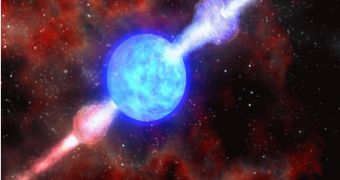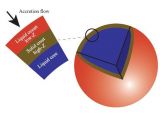For the first time, scientists have been able to decipher the mysteries of the neutron stars. Using computer simulations to reproduce the conditions in space, they have been able to find out their chemical composition and to learn more about the behavior of the matter under extreme pressures and temperatures.
Neutron stars are similar to onions, having many overlapping layers of materials, made up of different chemicals concentrated at different depths. This alters the strength of the gravitational waves emitted by the star and could help researchers understand the formation of the spectacular nuclear explosions seen tearing across their surfaces.
As the remains of a supernova blast, they have huge densities, of around a billion tonnes of matter packed into every cubic centimeter at their cores. Inside, the tremendous pressure crushes individual atoms and transforms them into a dense liquid of neutrons.
On the outside, the neutron star has a crystalline crust, which a low enough pressure keeps the atoms in their usual state. However, not all of them have the crust as a final covering layer.
Some slowly siphon material from a companion star and this material pools on top of the crust to form an outer liquid "ocean," where new materials form sediments on the bottom, again due to the immense pressure, adding new layers to the crust.
The new simulations suggest that, unlike previous theories, the new crust doesn't have the same chemical composition as the overlying ocean; instead metals like iron solidify more readily to form the new crust, leaving lighter elements such as oxygen to build up in the ocean.
Physicist Charles Horowitz of Indiana University in Bloomington, US, led the team that performed the experiments in a virtual environment.
Scientists created a model of a 17-elements mix, added to the outer layers of a virtual neutron star and the results contradicted the old theories that said that the new crust would have the same chemical composition as the ocean beneath.
This result could in fact explain the origin of giant nuclear explosions that occur every year or two on some neutron stars.

 14 DAY TRIAL //
14 DAY TRIAL // 
